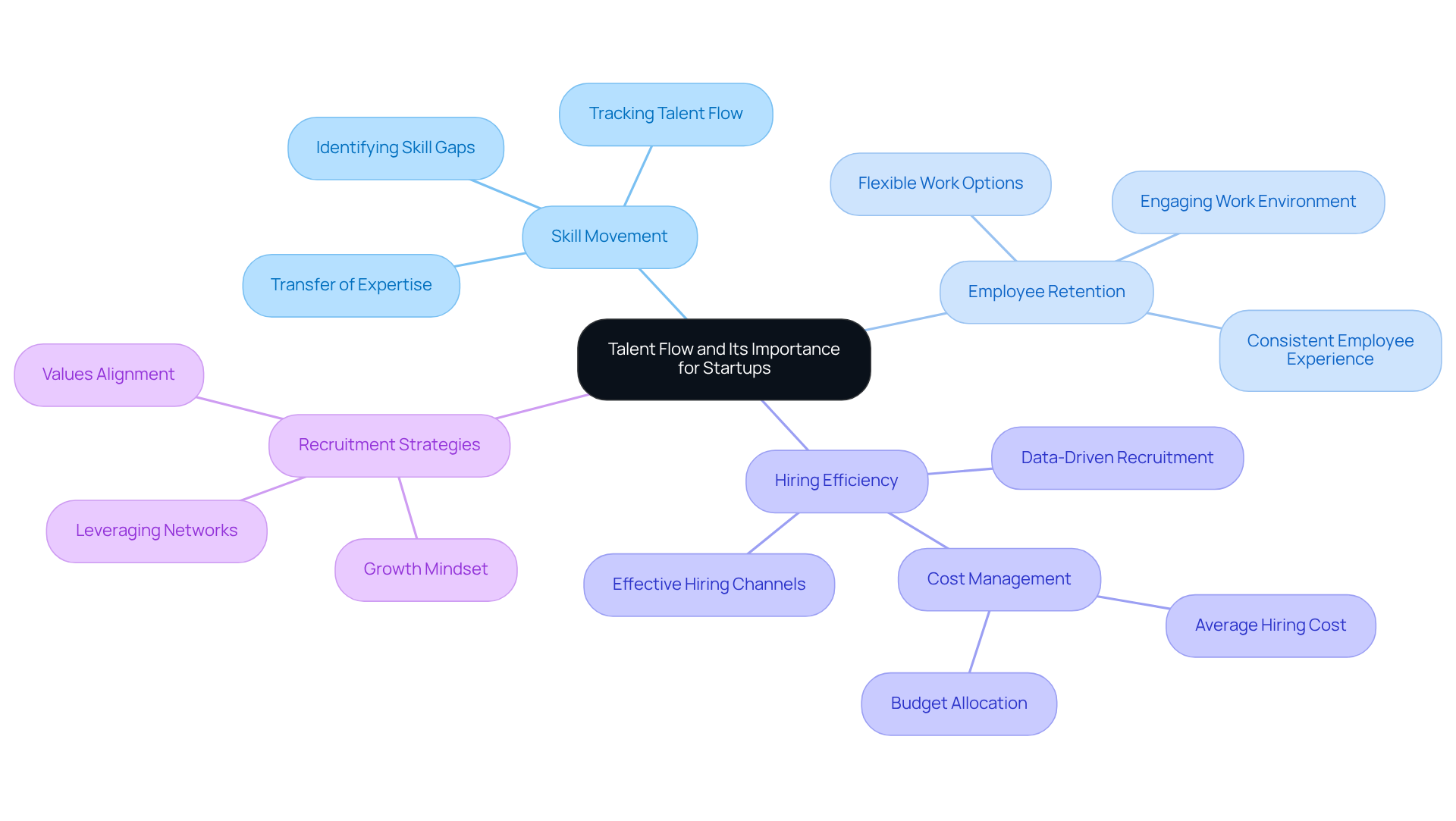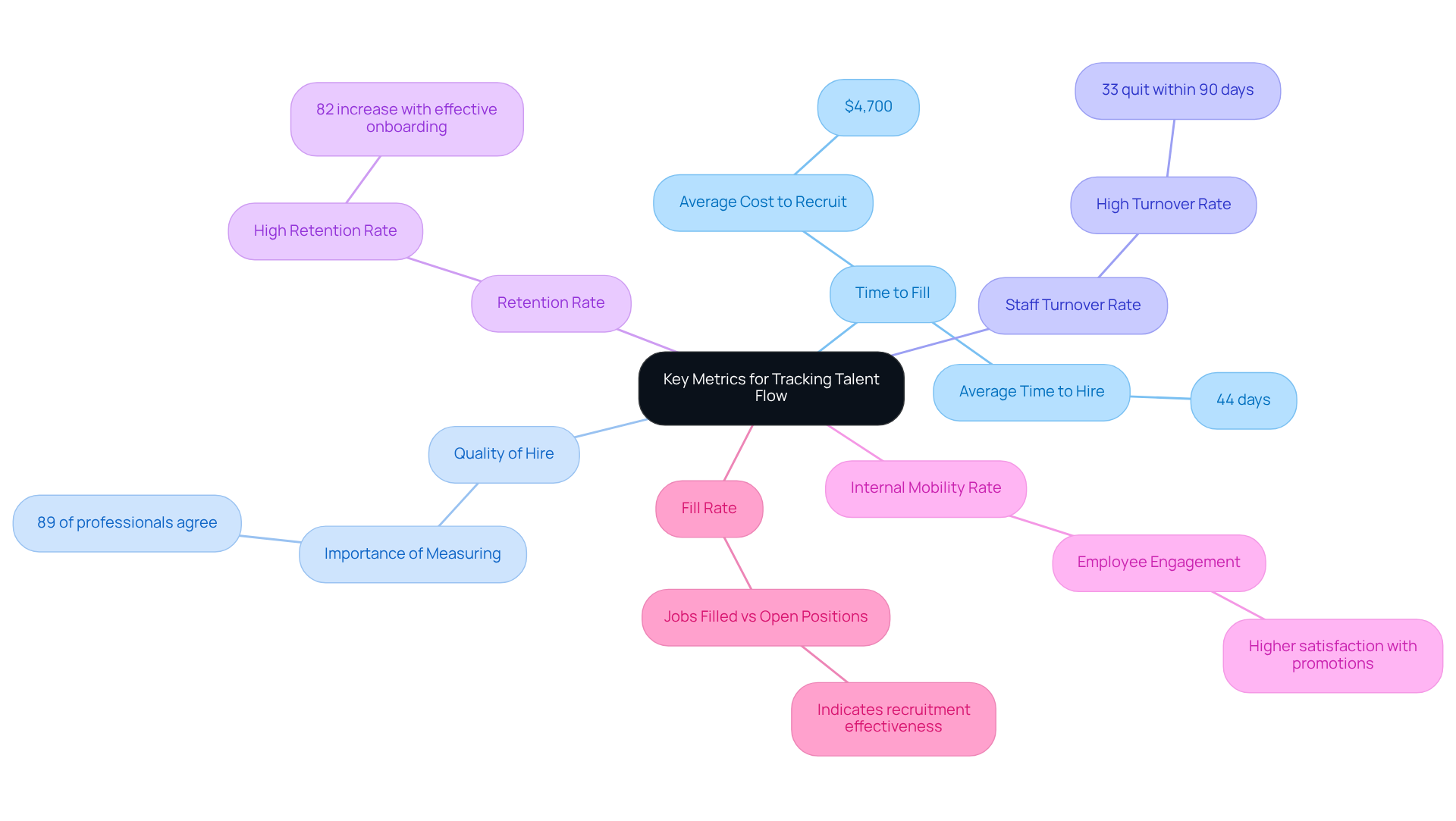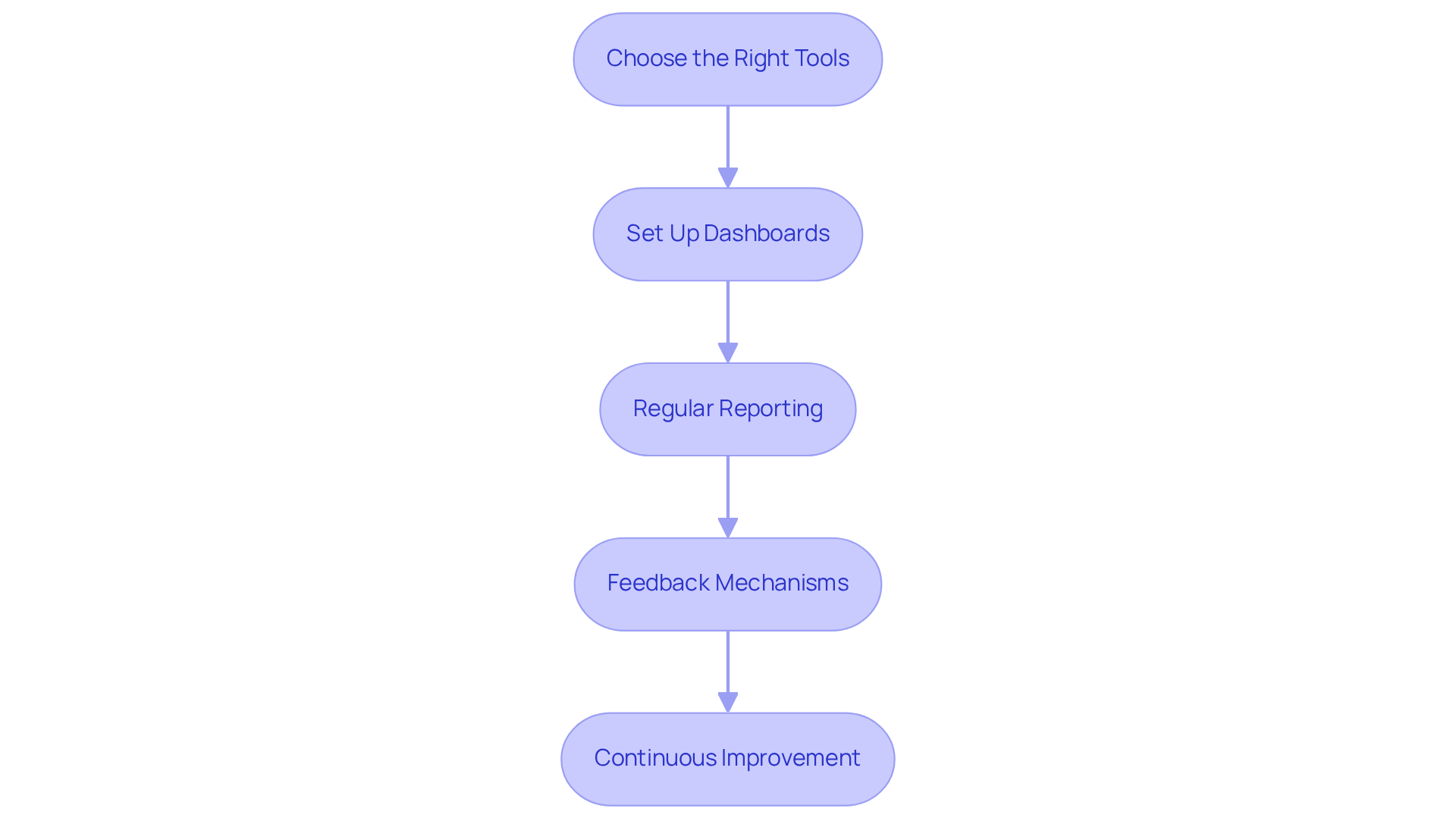Overview
To effectively track the flow of startup talent, it is essential for startups to grasp the dynamics of skill movement. This entails closely monitoring recruitment patterns, employee advancements, and exits. Such vigilance not only enhances employee retention but also boosts hiring efficiency. By analyzing key metrics—such as time to fill, quality of hire, and turnover rates—startups can refine their recruitment strategies. This analytical approach ensures they attract and retain the right talent necessary for sustainable growth.
Consider the implications: how can your startup leverage these insights to create a competitive edge? By understanding the nuances of talent flow, you position your organization to respond proactively to workforce challenges. The data-driven insights derived from these metrics empower startups to make informed decisions, ultimately fostering a robust talent pipeline that supports long-term success.
Introduction
Understanding the dynamics of talent movement is essential for startups navigating the competitive landscape of recruitment and retention. By effectively tracking startup talent flow, these businesses can uncover vital insights that enhance their hiring strategies and foster a thriving work environment. Yet, the challenge lies in managing the complexities of data overload, inconsistent metrics, and resistance to change. How can startups streamline their approach to talent flow and ensure they attract and retain the right people for sustainable growth?
Define Talent Flow and Its Importance for Startups
Skill movement encompasses the transfer of expertise within and among organizations, including recruitment, advancements, and exits. For new businesses, grasping the nuances of workforce movement is vital, as it directly impacts employee retention and hiring efficiency. By meticulously monitoring workforce movement, new companies can learn how to track startup talent flow, which helps uncover patterns that inform their recruitment strategies and ensures they attract and retain the right individuals essential for growth. This proactive approach not only reveals potential skill gaps but also empowers startups to address these challenges before they escalate.
Understanding the on staff retention is particularly critical. Startups that effectively evaluate their workforce movement can cultivate a more engaging work environment, which is essential for retaining top talent. Research indicates that businesses offering flexible work options experience 25% lower employee turnover rates, underscoring the importance of adapting to worker needs in the context of workforce movement.
Moreover, tracking personnel movement provides new businesses with insights into their hiring processes. By analyzing the effectiveness of various hiring channels and understanding the characteristics of successful recruits, these companies can refine their recruitment strategies. This data-driven approach not only improves the quality of hires but also decreases the average hiring cost, which is approximately $4,700, though it can vary from $1,000 to over $6,000 depending on the industry.
Successful new ventures have leveraged skill flow analysis to improve their understanding of how to track startup talent flow and significantly enhance their recruitment strategies. For instance, those who adopt a growth mindset and utilize their networks for sourcing capabilities have identified valuable candidates that resonate with their organizational values. Additionally, new businesses that prioritize a consistent employee experience from the initial candidate interaction are more likely to attract and retain exceptional talent, as 78% of candidates perceive the overall candidate experience as indicative of how a company values its workforce.
In conclusion, monitoring personnel movement transcends a mere logistical task; it is a strategic imperative that enables new ventures to cultivate a robust workforce capable of driving innovation and growth.

Identify Key Metrics for Tracking Talent Flow
To understand how to track startup talent flow, startups must focus on several essential metrics that provide critical insights into their recruitment processes and workforce dynamics.
- Time to Fill is a vital metric that measures the average duration required to fill open positions. This insight into recruitment efficiency is crucial, especially given that the average time to hire is around 44 days, with the average cost to recruit a new staff member at approximately $4,700. Understanding this metric allows organizations to identify bottlenecks and .
- Next, consider the Quality of Hire. Evaluating the performance of new hires over time is essential to determine if they meet the expected standards. Notably, 89% of talent acquisition professionals recognize that measuring quality of hire is increasingly important, as it has a direct impact on long-term business outcomes.
- The Staff Turnover Rate also warrants attention. Tracking the percentage of personnel departing the organization within a specific timeframe is critical. High turnover rates, which can reach as much as 33% for new hires within the first 90 days, may indicate underlying issues with company culture or job satisfaction.
- Equally important is the Retention Rate. Monitoring the percentage of staff who remain with the company over a specified duration is crucial. A high retention rate often reflects a positive work environment, with companies that invest in effective onboarding seeing an impressive 82% increase in new hire retention.
- Furthermore, the Internal Mobility Rate offers insights into employee engagement and career development opportunities. Evaluating how often individuals are promoted or transferred within the organization can indicate a thriving workplace. Companies that prioritize internal mobility often experience higher employee satisfaction and retention.
- Lastly, the Fill Rate measures the number of jobs filled compared to open positions, indicating the effectiveness of the recruitment team. A high fill rate suggests effective recruitment practices, while a low rate may signal issues in the recruitment strategy or candidate fit.
By concentrating on these metrics, new businesses can gain valuable insights into how to track startup talent flow, which enables them to make informed modifications to their hiring strategies and enhance overall organizational efficiency.

Implement a System for Monitoring Talent Flow
To implement a system for monitoring talent flow, startups can follow these essential steps:
- Choose the Right Tools: Start by selecting HR analytics software or applicant tracking systems (ATS) capable of monitoring key metrics and providing real-time data on workforce movement. Key HR metrics, such as turnover rate, time-to-hire, and employee engagement, are crucial for understanding workforce behavior, as highlighted by Abhinaya.
- Set Up Dashboards: Next, create dashboards that visualize these key metrics. This approach simplifies the monitoring of trends and helps identify areas for improvement. Dashboards are vital in HR analytics, enabling effective reporting and decision-making, which allows organizations to respond proactively to changes in workforce movements.
- Regular Reporting: Establish a routine for generating reports on personnel flow metrics. This enables timely analysis and decision-making. Notably, 82% of HR specialists utilize people analytics to evaluate staff retention and turnover, underscoring the importance of organized reporting in efficiently managing talent.
- Feedback Mechanisms: Implement feedback loops with staff to gather insights on their experiences and reasons for departure. This information can significantly inform retention strategies. Collecting feedback is essential, as it helps organizations understand employee sentiment and address potential issues before they lead to turnover.
- Continuous Improvement: Finally, regularly review and adjust the monitoring system based on feedback and evolving business needs to ensure its effectiveness. This practice aligns with insights from external sources that stress the necessity for ongoing evaluation and support for to drive measurable change.
By adhering to these steps, startups can establish a robust system that provides continuous insights into workforce dynamics, which is crucial for understanding how to track startup talent flow and facilitating proactive management of their staff.

Overcome Challenges in Tracking Talent Flow
Startups face significant challenges in understanding how to track startup talent flow. Firstly, data overload can be overwhelming, given the multitude of metrics available. To navigate this complexity, prioritize that align with your business goals, focusing on actionable insights that drive results.
Secondly, inconsistent data can hinder efforts. Standardizing data collection methods across the organization is essential for maintaining accuracy and consistency. This lays a solid foundation for effective tracking.
Moreover, resistance to change is a common hurdle. Employees may be hesitant to embrace new systems. To foster support, offer comprehensive training and clearly convey the advantages of monitoring workforce movement.
Limited resources also pose a challenge, as startups often operate on tight budgets. To manage costs effectively, consider leveraging affordable HR analytics tools or outsourcing certain functions.
Lastly, a lack of expertise in data analysis can impede progress. If your internal team lacks experience, hiring or consulting with experts can provide the necessary guidance for implementing effective tracking systems.
By proactively addressing these challenges, startups can significantly improve how to track startup talent flow, leading to better hiring and retention outcomes.
![]()
Conclusion
Understanding and effectively tracking talent flow is crucial for startups aiming to build a resilient and innovative workforce. By comprehensively monitoring skill movement, organizations can not only improve their recruitment strategies but also enhance employee retention and satisfaction. This strategic focus empowers startups to adapt to workforce dynamics, ensuring they attract and retain the right talent for sustainable growth.
The article outlines several essential metrics for tracking talent flow, including:
- Time to fill
- Quality of hire
- Turnover rates
- Internal mobility
Each of these metrics offers critical insights into recruitment efficiency and employee engagement, allowing startups to make informed decisions that enhance their hiring processes. Additionally, implementing robust monitoring systems and overcoming common challenges such as data overload and resistance to change are vital steps in creating a responsive and effective talent management strategy.
Ultimately, embracing a proactive approach to tracking talent flow not only facilitates better hiring and retention outcomes but also positions startups for long-term success. By leveraging the insights gained from monitoring workforce dynamics, new ventures can cultivate an environment that fosters innovation, collaboration, and growth. Startups are encouraged to invest in the necessary tools and strategies that will enable them to navigate the complexities of talent flow, securing their place in a competitive landscape.
Frequently Asked Questions
What is talent flow and why is it important for startups?
Talent flow refers to the movement of skills and expertise within and among organizations, including recruitment, promotions, and exits. It is important for startups because understanding this movement directly impacts employee retention and hiring efficiency, helping them attract and retain the right individuals essential for growth.
How can startups track talent flow effectively?
Startups can track talent flow by meticulously monitoring workforce movement to uncover patterns that inform their recruitment strategies. This proactive approach helps identify potential skill gaps and allows startups to address challenges before they escalate.
What is the relationship between skill movement and employee retention?
Effective evaluation of skill movement can help startups create a more engaging work environment, which is crucial for retaining top talent. Research shows that businesses offering flexible work options have 25% lower employee turnover rates, highlighting the need to adapt to worker needs.
How does tracking personnel movement improve hiring processes for startups?
Tracking personnel movement provides insights into hiring processes by analyzing the effectiveness of different hiring channels and understanding the traits of successful recruits. This data-driven approach enhances recruitment strategies, improves the quality of hires, and reduces average hiring costs.
What is the average cost of hiring, and how can startups reduce it?
The average hiring cost is approximately $4,700, though it can vary from $1,000 to over $6,000 depending on the industry. Startups can reduce hiring costs by refining their recruitment strategies through skill flow analysis and focusing on effective hiring channels.
What practices can help startups attract and retain exceptional talent?
Startups that adopt a growth mindset, utilize their networks for sourcing candidates, and prioritize a consistent employee experience from the initial candidate interaction are more likely to attract and retain exceptional talent. Additionally, 78% of candidates view the overall candidate experience as indicative of how a company values its workforce.
Why is monitoring personnel movement considered a strategic imperative for new ventures?
Monitoring personnel movement is a strategic imperative because it enables new ventures to cultivate a robust workforce capable of driving innovation and growth, rather than merely serving as a logistical task.




